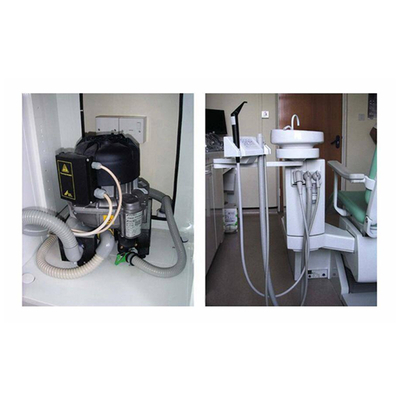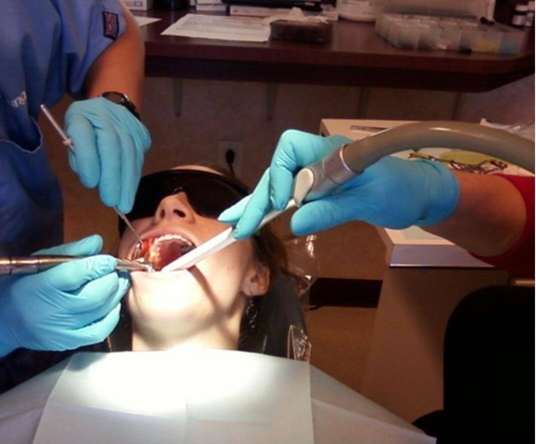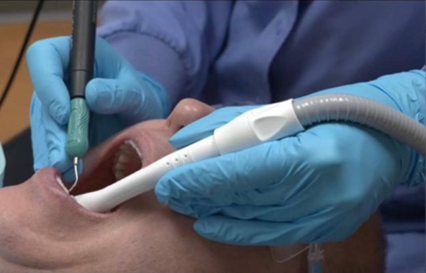In 1961, the German manufacturer Dürr Dental developed the first dental aspiration (suction) system, revolutionizing the way dentists operate. This innovation allowed dentists to transition from standing treatments to working with patients lying down on a dental unit, significantly enhancing control, hygiene, ergonomics, and comfort for both patients and specialists.
The dental suction device is one of the most essential pieces of equipment in a dental clinic. Its primary function is to reduce or eliminate contamination between the patient and the dentist through its motorized aspiration system. It creates a vacuum to suction all liquids and solids from the patient’s mouth during dental procedures, including saliva, blood, anesthetic fluids, amalgam particles, tooth fragments, and other debris.

The use of dental suction systems is crucial for several reasons:
1. Protection of the patient’s airway and respiration
Patients may feel anxious or undergo long procedures like implants and complex surgeries, requiring anesthesia for comfort. A dental suction system helps maintain the patient’s airway and breathing under anesthesia, preventing aspiration during treatment.
2. Removal of saliva to enhance bonding agents
In the bonding process, strong adhesive materials are used to ensure the restoration’s durability. However, during the procedure, the presence of foreign objects, like a dental mirror, can cause excessive saliva production. If there is too much saliva in the restoration area, it can weaken the bonding agent, making the restoration less effective. A dental suction system helps keep the area dry, ensuring that the restoration is securely bonded.
3. Preventing airway blockage during treatment
Choking is a common concern, especially in children or patients with sensitive airways, muscle weakness, or a history of oral or dental injuries. A high-quality dental suction system quickly removes saliva and surgical debris, significantly reducing the choking risk during procedures.
4. Environmental hygiene and infection control
During cosmetic and restorative treatments, high-speed dental instruments, like polishers, can create aerosols from saliva, bacteria, and microbes, which can spread through the air and contaminate surfaces. This increases the risk of cross-infection for both patients and dental professionals. A dental suction system reduces these harmful aerosols and prevents their spread, maintaining a sterile and safe environment for everyone in the clinic.
How the Dental Aspiration System Works
There are two types of dental suction systems: wet suction and dry suction.
Wet Suction
In wet suction systems, there is no air-liquid separator within the dental unit, meaning both air and liquids enter the suction system. The motor operates dry, but the system includes an air-water separator to prevent any liquid from reaching the motor. The liquids are then sent to a waste drainage system located in a dedicated utility room.
Advantages of Wet Suction
- Modern and low-maintenance, preferred in newer dental clinics.
- Offers high efficiency, providing 300 liters per minute of vacuum pressure per suction cannula.
Disadvantages of Wet Suction
- The motor must be positioned at the same level as the dental unit.
- Requires a waste drainage system in the utility room.
Dry Suction
A dry suction system uses a centrifugal or disc separator to separate air and liquid within the dental unit. The liquids are directed to a waste drainage system under each dental unit, while only dry air reaches the suction motor.
Advantages of Dry Suction
- Cost-effective compared to wet suction.
- Maintains good suction performance at 300 liters per minute per suction cannula.
- Does not require a drainage system in the utility room.
- The motor can be positioned higher than the dental unit.
Disadvantages of Dry Suction
- Requires more frequent maintenance than wet suction.
- Each dental unit requires its own waste drainage system.

Before equipping your clinic with a dental aspiration system
the first and most important thing to consider is whether you prefer a dry or wet suction system. Once you have acquired your aspiration system, it is crucial to think about its cleaning and maintenance. To prevent unpleasant odors, blockages, and ensure proper functioning, you should clean the system daily with disinfectants. Additionally, another point to pay attention to is the new European regulations regarding amalgam separators. Since January 2019, amalgam separation in dental aspiration systems has been mandatory for all dental clinics.
There are generally two types of dental suction systems:
- Saliva Ejector (Blue Suction)
- High Volume Evacuator (HVE)
Saliva Ejector
This type of suction is used in routine dental treatments to remove saliva from the patient’s mouth. It is placed on a part of the dental unit called the assistant’s tablet or table, where other components like air and water syringes may also be located. One downside of this suction system is that it results in significant water wastage, with an estimated 8 to 13 liters of water consumed per minute. Given the time-consuming nature of most dental procedures, the daily water consumption and the total amount of water used over time can become quite substantial. For this reason, it is recommended that dental clinics replace traditional water-based suction systems with electric or air-powered models.
Air Suction
Air suction is another common type of dental suction. The dental assistant places the air suction close to the area that requires treatment, allowing it to collect all materials, fluids, and dental debris that break off during the procedure. The operation of air dental suction is similar to that of a high-powered vacuum cleaner. This type of suction is capable of efficiently collecting all the remaining debris and fluids in the mouth without needing to touch the teeth, simply through suction.
Ideal Suction Features
- It should have a high-quality motor and strong suction power.
- The suction unit’s body should be easily sterilizable.
- The suction containers should have a high capacity.
- It should have a high output power.

